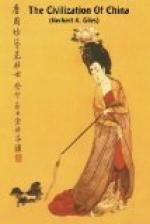CHAPTER II—LAW AND GOVERNMENT
In the earliest ages of which history professes to take cognizance, persons who wished to dispose of their goods were obliged to have recourse to barter. By and by shells were adopted as a medium of exchange, and then pieces of stamped silk, linen, and deerskin. These were followed by circular discs of copper, pierced with a round hole, the forerunners of the ordinary copper coins of a century or two later, which had square holes, and bore inscriptions, as they still do in the present day. Money was also cast in the shape of “knives” and of “trouser,” by which names specimens of this early coinage (mostly fakes) are known to connoisseurs. Some of these were beautifully finished, and even inlaid with gold. Early in the ninth century, bills of exchange came into use; and from the middle of the twelve century paper money became quite common, and is still in general use all over China, notes being issued in some places for amounts less even than a shilling.
Measures of length and capacity were fixed by the Chinese after an exceedingly simple process. The grain of millet, which is fairly uniform in size, was taken as the unit of both. Ten of these grains, laid end-ways, formed the inch, ten of which made a foot, and ten feet a chang. The decimal system has always prevailed in China, with one curious exception: sixteen ounces make a pound. How this came to be so does not appear to be known; but in this case it is the pound which is the unit of weight, and not the lower denomination. The word which for more than twenty centuries signified “pound” to the Chinese, was originally the rude picture of an axe-head; and there is no doubt that axe-heads, being all of the same size, were used in weighing commodities, and were subsequently split, for convenience’s sake, into sixteen equal parts, each about one-third heavier than the English ounce. For measures of capacity, we must revert to the millet-grain, a fixed number of which set the standard for Chinese pints and quarts. The result of this rule-of-thumb calculation has been that weights and measures vary all over the empire, although there actually exist an official foot, pound and pint, as recognized by the Chinese government. In one and the same city a tailor’s foot will differ from a carpenter’s foot, an oilman’s pint from a spirit-merchant’s pint, and so on. The final appeal is to local custom.
With the definitive establishment of the monarchy, two hundred years before the Christian era, a system of government was inaugurated which has proceeded, so far as essentials are concerned, upon almost uniform lines down to the present day.




